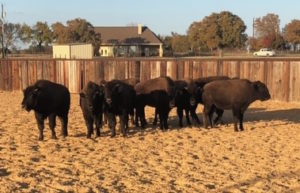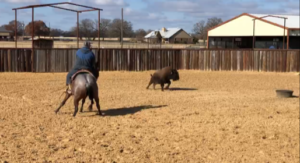
Buffalo getting a feel for the arena
They’re goggled-eyed, mop-headed, unbalanced looking creatures that can seem downright intimidating, but the ungainly bison can be a cutter’s best friend when it comes to tuning your horse.
With constant supplies of fresh cattle a fantasy for most cutters, buffalo are a much more affordable substitute. Unlike cows which sour quickly after being worked, buffalo can be used to train six to eight horses a day for a number of years, provided you handle them right.
Almost 20 years ago, Hall of Fame cutting horse trainer Randy Chartier started to add buffalo to his program. Originally from Michigan, Chartier found it almost impossible to get cows. When he did, they were not good to work plus they added a huge expense to his business.
A friend in Missouri had buffalo and recommended he try them. He purchased six buffalo assuming he could easily figure them out. He worked them out of a herd but it was not successful, he said.
One winter, Chartier eventually realized that bison work better one at a time in his indoor pen. When the weather improved, he put them in the round pen outside and it worked.
“Throughout the winter, working them one at a time, these buffalo had become trained and at ease. They made a great little herd of animals to work out of,” he said.
He worked the initial herd of six buffalo for a couple of years. While Chartier learned by trial and error, he suggested those with no experience are better off buying buffalo that have been trained.
When Chartier came to Texas, he found cattle were still not much easier to come by, so he decided to stick with buffalo and help others use them too.
Chartier and Rob Foster started Double R Buffalo Boys which trains buffalo for people to use in their cutting programs. They sell to a wide variety of people from aged event barns to two year old trainers and reined cow horse programs. Chartier has now been training buffalo for 18 years, selling 150 horse-ready buffalo each year.
Chartier’s sons, RL and Cullen, each have three buffalo on their ranches as well.
Double R Buffalo Boys purchases the animals at different prices depending on the market. Anywhere from $1,000 to almost $2,000 and he adds $500 as a training cost.
“I have not had cattle on my place for 15-16 years!” Chartier said.
He is a huge believer in buffalo and believes his horses have benefited from the consistency of the way they work.
“It’s not just the money that you save overall, it’s the repetition that you get day in and day out everyday. My place and 99% of the places I send the buffalo to are a happier place than they were before.”
“Don’t get me wrong, there’s nobody that likes a fresh cow better than a cutter. A good fresh cow is awesome, but they only last one to two times and then you have nowhere to go with them. You have to feed them and take care of them and [keep] them for that 45-60 days.”
Chartier trains weanlings, so they are cheaper to feed than cattle. While bison can get similar illnesses as cows they are less likely to fall ill because of having much smaller herds.
“One buffalo is worth 100 head of cows. So if I keep six buffalo versus 600 head of cows, I’m going to have less sickness,” Chartier said.

Duncan Steele-Park training a buffalo
Trainer Duncan Steele-Park, originally from Australia, has trained 50 buffalo for training cutting horses over the years.
“You can work seven to eight horses nearly everyday on a buffalo for four to five days a week. If you treat them consistently and treat them right,” Duncan said.
Steele-Park agreed they eat less than a cow, but said they may need more feed, depending on how much they are worked.
When training a buffalo, Chartier said quality means a lot. A good quality buffalo is smarter.
While there are different ways to train a buffalo, the most important factor is consistency.
Chartier said buffalo are so good to work because they move voluntarily without needing turnback help. Heifers are better for that purpose. Chartier sells the heifers out of state unless bulls are specifically requested. He said he tries to keep the bulls close by so he can step in and help if necessary.
“I handle mostly females because I can count on the females to be mostly [useful] at a longer term than a bull. The bulls get a little gentle. They don’t get nasty or belligerent until they become of [breeding] age.”
After the buffalo first arrive, Chartier lets them settle in for a week to 10 days before starting his training process in groups of six to eight at a time.
Buffalo are more intensely herd-oriented than cattle. Chartier’s program separates the buffalo everyday. He teaches them it’s okay to be alone. He said it’s crucial that they be acclimated to working one at a time and then they can be put in a herd.
Steele-Park brings the buffalo into the arena when they first get to the ranch and walks away to let them get settled. He does it as a group because they will relax each other, he said. He wants them to sniff every inch of the arena and get very comfortable, which he will repeat for the first three to four days.

Randy working a horse on buffalo
“Buffalo are really perceptive and they love consistency and they love a pattern. When they know what the routine is, they are fantastic but if you change that routine up they will start to get more alert and start to panic,” Steele-Park said.
He makes sure he lets the buffalo into the arena one by one, not as a group.
“When you teach a buffalo something, it’s pretty much written in stone that that’s the way it’s going to be.” Be sure to make everything the buffalo’s idea, Steele-Park said.
A buffalo will challenge the handler any time they see a change in the routine, Steele-Park said. In Australia, Steele-park would gather the buffalo everyday on the same horse and the buffalo would come into the arena without a problem. One day he switched horses and the buffalo were more resistant. He had to remind them what to do.
Unlike Chartier, Steele-Park prefers to work and train his buffalo with a turnback rider. Both the cutter and turnback rider put pressure on the buffalo and release the animal when it goes where directed.
“They’ve got to know there is a release somewhere in the arena,” Steele-Park said.
Chartier said you need to spend five to six days a week training the bison. You can’t work with them a few days a month and expect to get them trained.
“Use ranch horses or turn back horses, horses you can spend some time on and teach the buffalo to not want to go around you and [teach them] to be by themselves,” he said.
Steele-Park prefers not to work the buffalo up against the wall because they turn into the wall and not into the horse.
“When you are training them it is really important that you have a horse that is comfortable because as soon as the buffalo learns he can beat you, he will try that pretty consistently nearly every time,” he said.
If you try to run them around and get your horse cowed up, buffalo won’t be successful in your program according to Steele-Park.
“Buffalo are a tool to get your horse to travel across the arena and stop when the cow stops and turn when the cow [turns],” he said.
Chartier said once the bison are broke, they last a long time. “A lot of these guys that I sell buffalo to don’t bring them back to

Duncan working a colt on buffalo
trade them in for at least a year and a lot of them, it might be 18-24 months.”
It takes 30-45 days for Chartier to get a buffalo trained. Buffalo are very smart and they love repetition. He always hand feeds them and makes them come to where he wants them to be fed.
“I used to give a lot of lessons on buffalo and people are [skeptical] at first and once they do it that’s all they want to work. They have more fun working something that wants to stay away from them and give them a little play than some old cow that wants to walk over them or go to the fence and put their head down,” he said.
“My guarantee is if you have a problem, I’m the guy that fixes it. If they don’t work for you, they don’t work for me. It has to be a mutual deal.”
“I do buffalo because I like them, not because I make a profit on them.”
“I want to hold the first buffalo cutting in Parker County. That’s on my bucket list,” said Chartier.
➤ Watch Duncan’s videos on how to train buffalo for cutting horses on CHTO
Brought to you by Dual Reyish